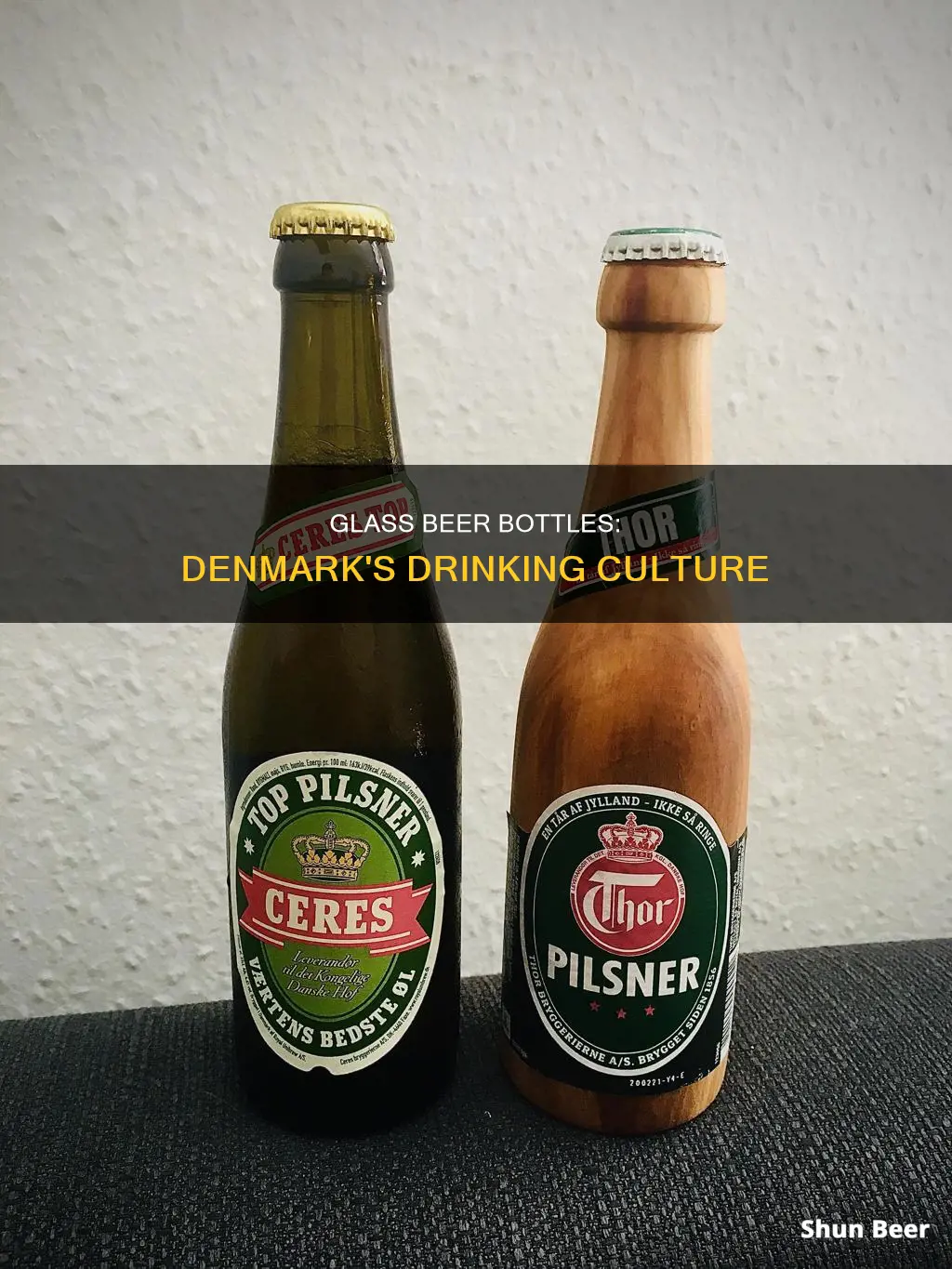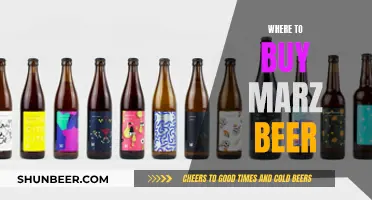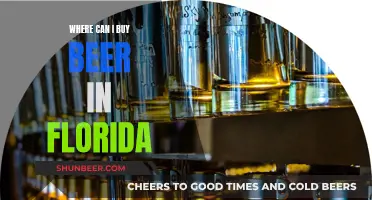
Denmark has a deposit and return system for recycling drink cans and bottles, which includes beer. The country's return and deposit system originated over 100 years ago, when it was common to collect and refill glass bottles. Since 2002, a nationwide system has been in effect, covering single-use cans and bottles made from plastic, glass, and aluminium, with a 90% collection rate consistently achieved. Under this system, beverage producers charge consumers an additional deposit fee, which is refunded when empty containers are returned. This deposit system is a key factor in the high rate of return, as it is easy for consumers to return their used beverage containers, no matter where they were initially purchased.
| Characteristics | Values |
|---|---|
| Can you buy beer in glass bottles in Denmark? | Yes |
| Is there a deposit system in Denmark? | Yes |
| What is the deposit system? | Consumers pay an additional deposit amount when purchasing a product. They can then return the empty bottle or can and receive their deposit back as cash. |
| What is the deposit mark? | A series of dots under two arrows in a circle. |
| What is the deposit for glass bottles under 0.5L? | DKK 1.00 |
| What is the deposit for glass bottles over 0.5L? | DKK 3.00 |
| How do you return bottles and cans? | Reverse vending machines, deposit stations, or staff at grocery stores or gas stations. |
| What happens to the bottles and cans after they are returned? | They are recycled, melted, and turned into new bottles and cans. |
What You'll Learn

Denmark's deposit and return system for glass bottles
Denmark has a deposit and return system for glass bottles and other beverage containers. The system is called the 'Pantstation' or 'Danish Return System' and is operated by a non-profit organisation established by the breweries in Denmark. The system was first implemented in 1922, where glass bottles were required to be returned for reuse due to material scarcity during World War 1. The current version of the system has been in place since 2002 and covers single-use cans and bottles made from plastic, glass, and aluminium.
The way the system works is that beverage producers in Denmark charge consumers the price of their product plus an additional amount known as a deposit. Consumers can then return the empty bottle or can to any supermarket or kiosk and receive their deposit back in cash. The deposit mark is usually printed directly on the bottle or can, or it may be a small sticker attached to the packaging. The mark always has a series of dots under two arrows in a circle, and it is a registered trademark owned by Dansk Retursystem.
There are several ways to return bottles and cans for a deposit refund. The most common method is through reverse vending machines (RVMs) found in many supermarkets. These machines scan the deposit mark, barcode, and shape of the container, then calculate the refund amount. Consumers can also manually return their containers to supermarkets or kiosks, or they can take them to a 'Pantstation' depot. At larger supermarkets, special machines scan, separate, and compress the containers, and the packaging is then collected by the Danish Return System for recycling. Smaller shops without these facilities return the whole cans and bottles.
The deposit and return system is an essential part of Danish culture, with many children and teenagers collecting empty cans and bottles to return for cash. The system is also environmentally beneficial, as it reduces the energy and raw materials required to produce new bottles and cans. For example, manufacturing a can from a used can requires 95% less energy than producing a new one. Additionally, the high return rate of the system ensures a dynamic market for canned and bottled beverages.
Beer Buying at RDU: What's Allowed?
You may want to see also

The history of Denmark's bottle return system
Denmark's bottle return system has its origins over 100 years ago, when it was commonplace to collect and refill glass bottles. The first type of "bottle return" system in the world was hosted in Denmark in 1922, where glass bottles were required to be returned for reuse due to the scarcity of the material during World War I.
Since then, the system has been expanded several times. In 2002, a nation-wide system was implemented that covered single-use cans and bottles made from plastic, glass, and aluminium. This was due to the previous system violating the European Union Packaging Waste Directive. The most recent addition to the scheme was fruit juice bottles in 2020.
The way the return and deposit system works is that beverage producers in Denmark charge consumers the price of their product plus an additional amount known as a deposit ('pant' in Danish). Consumers can then return the empty bottle or can to any supermarket or kiosk and receive their deposit in return as cash, regardless of where they initially purchased the beverage. The deposit mark is owned by Dansk Retursystem and can be printed or stuck on the bottle or can.
The Danish Return System, established by the breweries in Denmark, is responsible for collecting, processing, and returning the empty bottles and cans to producers to be recycled. When sending beverages to shops, the producers send a corresponding deposit to the Danish Return System. Shops and supermarkets refund deposits to the consumers and then receive the corresponding amount from the Danish Return System in return once the empty bottles and cans are collected and counted. The deposit money flows continuously throughout the system, so it breaks even rather than making a profit.
The Danish deposit and return system is an important part of Danish culture. Many children and teenagers have gone around their neighbourhoods collecting empty cans and bottles to return at the machines installed in supermarkets and kiosks in exchange for coins, which they often use to buy treats.
St. John Brewers Beer: Availability in the US?
You may want to see also

The Danish Return System organisation
The Danish Return System (DRS) is a non-profit organisation that handles the Danish Container deposit system. It was founded in 2000 by Denmark's breweries in conjunction with supermarket chains and is now regulated by the Ministry of Environment. The DRS is funded by fees paid by beverage companies and deposits on bottles that are never returned. This money is then used to improve the system.
The DRS operates the country's deposit and return system, which is one of the few areas in which producers and importers pay for packaging to be recycled. The system works by charging consumers an additional amount, known as a deposit, on top of the price of their beverage product. Consumers can then return the empty bottle or can to any supermarket or kiosk and receive their deposit back in cash. The deposit mark is always a series of dots under two arrows in a circle and may be printed directly on the bottle or affixed as a small sticker.
The DRS is responsible for collecting, processing, and returning empty bottles and cans to producers to be recycled. When sending beverages to shops, producers send a corresponding deposit to the DRS. Shops and supermarkets refund deposits to consumers and then receive the corresponding amount from the DRS once the empty bottles and cans are collected and counted. The deposit money flows continuously throughout the system, breaking even rather than making a profit. Unclaimed deposits are kept by the DRS to finance and develop the system.
At larger supermarkets, special machines scan, separate, and compress the cans and bottles, and the packaging is then collected by the DRS to be recycled at one of their two sorting plants. Smaller shops without these facilities return the cans and bottles whole. The DRS ensures that the bottles and cans are sorted, separated, and sent to specialised plants to be melted down and transformed into new cans and bottles.
The Danish deposit and return system is central to Danish culture, with a dedicated verb in the Danish language: "at pante", meaning the process of scavenging for empties and returning them in exchange for coins. The system has been so successful that it has achieved a 90% collection rate since its inception in 2002, with a record 1.9 billion bottles and cans deposited for reuse in 2021.
Buying Beer at Kansas Gas Stations: Is it Possible?
You may want to see also

The environmental impact of Denmark's bottle return system
Denmark has a long history of using bottle return systems, with the first type of "bottle return" system appearing in 1922, where glass bottles were required to be returned for reuse due to material scarcity during World War 1. The current deposit system, which includes single-use containers, was implemented in 2002. This system is known as the "Pant" system in Danish, and it has become an integral part of Danish culture.
The bottle return system also helps to create a closed-loop production system, where the high value of materials like glass, metal, and plastic is preserved. Refillable bottles deposited in Denmark can be reused up to 30 times, while cans and single-use plastic bottles and glass bottles are melted down and used to produce new containers. This "bottle-to-bottle" and "can-to-can" loop preserves the value of the materials, saves virgin resources, and emits less CO2. In 2021, the return and recycling of 1.9 billion bottles and cans resulted in a 14% reduction in CO2 emitted per collected item compared to 2020, preventing the emission of 210,000 tonnes of CO2.
The Danish Return System, a non-profit organisation established by the breweries and approved by the Danish Ministry of Environment, plays a crucial role in the process. They are responsible for collecting, processing, and returning empty bottles and cans to producers for recycling. The system is funded by the unclaimed deposit money, which is used to finance and develop the process.
The convenience of the system, with over 3,000 return locations, including reverse vending machines, deposit stations, and pantstations, also contributes to its success. The high rate of return, consistently above 90%, ensures a dynamic market for canned and bottled beverages and has made the system an integral part of Danish culture.
Buying Beer on Saturdays: Extended Hours, No Limits
You may want to see also

Returning beer bottles bought abroad
Now, for bottles or cans purchased abroad, there are no deposits because Danish law does not apply. However, you can still return these containers to a Pantstation (deposit return bank) or some reverse vending machines. You will not receive any deposit refunds, but returning them helps the environment by conserving raw materials and reducing the energy required to produce new bottles and cans.
When returning bottles or cans bought abroad, look for the Danish deposit mark, which is a series of dots under two arrows in a circle. This mark indicates that the container is part of the Danish deposit and return system. If the mark is present, you may be able to receive a deposit refund. However, this depends on the retailer, as stores themselves decide whether to accept cans from abroad.
Additionally, if you have large bottles or cans purchased abroad, keep in mind that they may not fit into a reverse vending machine. In such cases, you would need to return them manually to a store that accepts them.
Overall, returning beer bottles bought abroad in Denmark is possible, but you may not receive deposit refunds for these containers. Nevertheless, returning them helps contribute to environmental conservation and sustainable practices.
Best Places to Buy Barrilitos Beer
You may want to see also
Frequently asked questions
Yes, you can buy beer in glass bottles in Denmark.
In Denmark, there is a deposit and return system for glass bottles. When buying a glass bottle of beer, consumers pay an additional amount as a deposit, which they can get back when they return the empty bottle to a supermarket or kiosk.
The deposit return system in Denmark is operated by the Danish Return System, a privately-owned, non-profit organisation established by the breweries. The system collects, processes, and returns empty bottles to producers for recycling. Producers send the corresponding deposit amount to the Danish Return System when sending beverages to shops, and shops refund deposits to consumers. The deposit money flows continuously through the system, breaking even rather than making a profit.
The returned bottles are recycled and transformed into new cans and bottles. The high value of glass, metal, and plastic is preserved through this closed-loop production system. Glass bottles are reused up to 30 times, while cans and single-use plastic bottles are melted down and used to produce new ones.
The deposit return system in Denmark has been very successful, consistently achieving a 90% collection rate for disposable bottles and cans. In 2021, the return percentage of disposable packaging reached 93%. The system is convenient for consumers, who can easily return their used beverage containers, and it offers both environmental and financial benefits.







